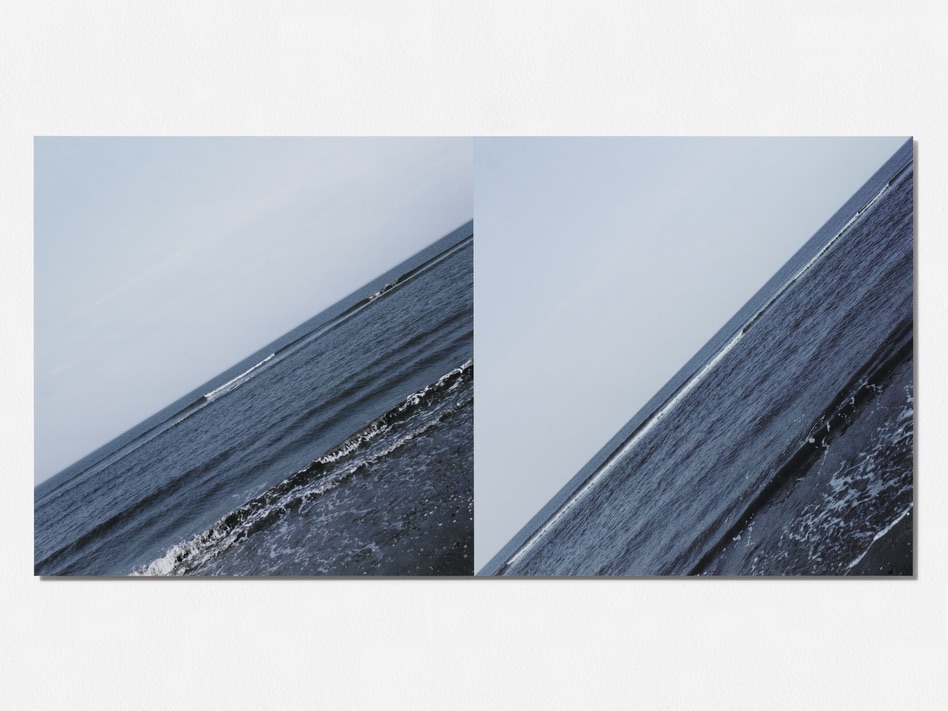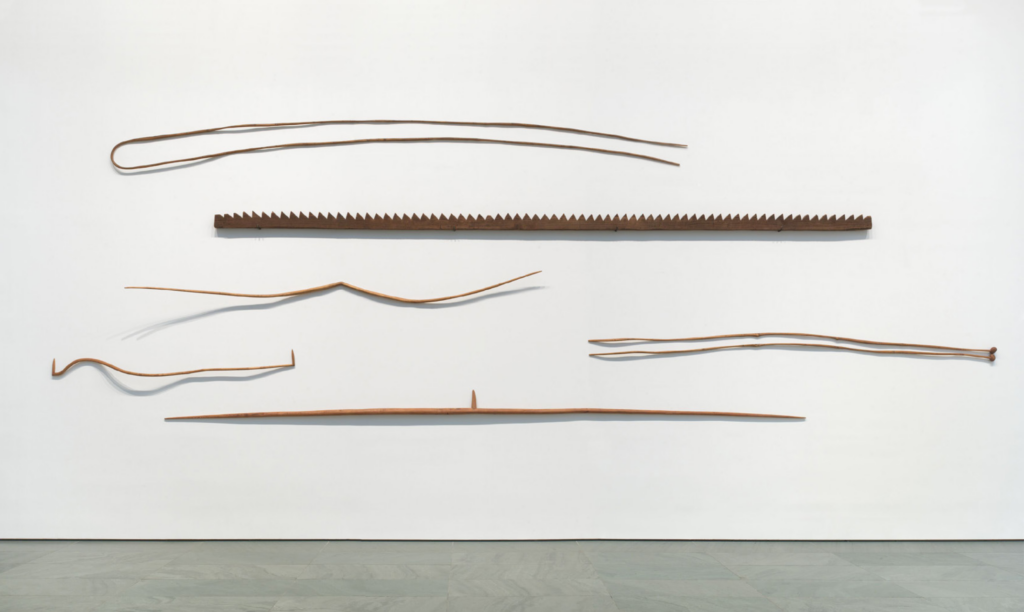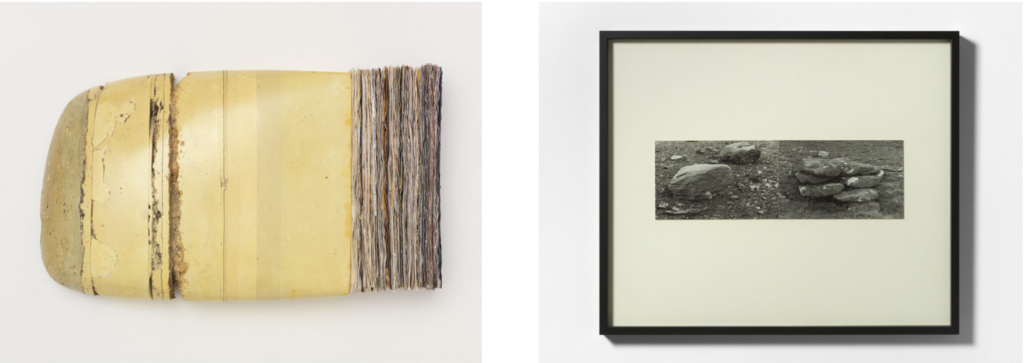Hauser & Wirth St.Moritz, St.Moritz, 9. Juli – 3. Oktober 2021.

Over the course of five decades, internationally renowned collectors Giuseppe and Giovanna Panza built a remarkable contemporary art collection of works by minimal and conceptual artists. As part of Hauser & Wirth’s ongoing collaboration, the gallery will host ‘Map and Territory. Environmental Art from the Panza Collection’ in St. Moritz, an exhibition focusing on the relationship between the environment and minimal art. A collection of unparalleled depth, the Panzas played a fundamental role in introducing American modern art movements to European museums. In particular, Dr. Giuseppe Panza was a pioneer of land and environmental art, and even sought to create the first environmental art museum, an unrealised project. This exhibition will bring together a selection of sculptures, drawings, and photography by esteemed artists from the collection, including Martin Puryear, Roni Horn, Richard Nonas, David Tremlett, Jan Dibbets, Hamish Fulton, Emil Lukas, Gregory Mahoney, Christiane Löhr, Ron Griffin, and Carole Seborovski.
Panza’s commitment to environmental causes is expressed in his memoir ‘Giuseppe Panza: Memories of a Collector’: ‘Nature is both mother and father, loving yet severe; it does not forget the offences we inflict on its virginity, and one day it will make us pay for our sins and offences, perhaps after generations. Those who love nature also love humanity and respect others. They love and respect all that is living because it comes from nature’.
Following a presentation of the archives and practices of the Panza Collection at Hauser & Wirth London in 2018, this exhibition is an example of the gallery’s commitment to building entire discourses around important 20th century collections. The presentation coincides with the art and design fair NOMAD St. Moritz taking place from 8 to 11 July.
Varying in size, texture, material, colour and shape, the featured artists engage with issues of the environment in their own unique interpretations. A highlight of the presentation is Martin Puryear’s ‘Some Tales’ (1975 – 1978) a work which survived a fire that destroyed Puryear’s studio in 1977. The curving wooden branches of the work trace how natural materials can be turned into cultural objects through a process of selection and transformation. For Giuseppe Panza, Puryear was ‘one of the greatest sculptors of the twentieth century’, his forms ‘were not geometric and rational but followed the twisting of living and growing things’.

Roni Horn’s ‘Thicket No. 1’ (1989) makes reference to the environment through the artist’s use of language. Utilising text appropriated from ‘Gravity and Grace’ by French writer Simone Weil, the sculpture reads ‘to see a landscape as it is when I am not there’ along two of its edges, acting as a reminder for viewers to appreciate nature without projecting pre-existing cultural concepts.
Gregory Mahoney’s practice involves travelling to natural sites to gather materials and using these to evidence natural processes at work, such as the use of rusting steel in ‘Percolate/Evaporate’ (1992), or combining these found objects with salt and other corrosive elements to mimic or amplify environmental effects, as in ‘North (Two Bears)’ (1993).
Common materials are also Richard Nonas’s sculptural starting point in ‘Mound’ (1975) and ‘Salita Nord No.1 (1 Down)’ (1974). His process is removed from conceptual approaches and rigid schemes, instead letting his works evolve from the emotional power of simple objects and the charge that human contact brings to material.
Likewise, Emil Lukas’s stone-like sculptural works are made from a wide range of inexpensive materials such as plaster, paper, studio waste and sawdust. Panza wrote about Lukas’s transformation of these materials after a studio visit in 1993: ‘In one corner of the room was a pile of things to be thrown away: cloth, paint, paper, all soft things that could then be welded to other simple materials with plaster. An unusual operation. When he finished his layers he would then cut them into slices, and it was fascinating to see the result of all these things together. This was the record of a day, the residue, the life of a day. The stratifications were undoubtedly beautiful’.

For artists like Ron Griffin, materials are directly sourced from nature. ‘Untitled (RGP 220-94)’ (1994) is composed of a long piece of wood ‘in which you can see a sunset in the desert or the sun rising’, elevating a humble material into something precious.
Christiane Löhr celebrates the small and delicate aspects of nature that we often overlook, using organic materials to create light and airy sculptures, such as strands of horsehair in ‘Haararbeit (Lavoro di crine)’ (2003).
In his various drawings, David Tremlett uses abstract forms and lines to respond to nature and the environment. His approach of travelling to various locations is similar to those associated with land art.
Also working in the mode of drawing, Carole Seborovski’s minimalist approach, achieved through a restrained colour palette, enables the landscape to be reduced into a simple geometric form in ‘Cross Shape Valley’ (1986).
Jan Dibbets’s ‘Sea Horizon 0°-135°’ (1971) repeats the same seascape at various angles, created by rotating the camera on its axis and disorientating the horizon. By combining photography with land and minimal art, Dibbets creates a dialogue between nature and geometry.
Similarly engaging photography is walking artist Hamish Fulton. In ‘Untitled’ (1972) and ‘Dim Trails’ (1972), Fulton investigates nature on foot and finds areas untouched by human presence, elevating the action of walking and sharing his experience with others.
In dialogue with the mountainous landscapes of the Engadine valley, ‘Map and Territory. Environmental Art from the Panza Collection’ provides an insight to the extraordinary collection of Giuseppe and Giovanna Panza. As the Panzas have said, ‘To understand the spirit of the Panza Collection, it takes time, silence, and a little solitude’. The exhibition will be accompanied by a virtual symposium ‘The Nature of Representation, The Representation of Nature’ in September 2021.
About the Panza Collection
Giovanna and Giuseppe Panza (1923-2010) are considered among of the world’s foremost collectors of modern and contemporary art of the 20th and 21st century. Their pioneering collection spans three generations encompassing abstract expressionism, minimal and conceptual art, and environmental and land artists. The latter sought to remove expressive, narrative or symbolic interpretations in order for the viewer to concentrate on qualities of light, colour, space and materials. The Panzas’ approach to collecting was marked by a desire to collect art that few museums or private collectors at the time were willing to acquire, such as conceptual works that exist only as documentary certificates or room-sized installations that require significant storage space.
Giuseppe Panza arranged important gifts and loans that greatly enhanced the collections of numerous American museums such as the Museum of Contemporary Art in Los Angeles and the Guggenheim in New York. A small part of his 2,500-piece collection remains in the 18th century Villa Menafoglio Litta Panza at Varese outside Milan, where an ever-evolving exhibition is on view.
Hauser & Wirth St. Moritz
Via Serlas 22 7500 St. Moritz
Gallery hours:
Tuesday to Sunday 2 pm – 7 pm
or by appointment
www.hauserwirth.com
Caption and courtesy information:
Jan Dibbets
Sea Horizon 0°-135° (detail)
1971
10 color photographs on aluminum, 5 panels 48.8 x 490 x 1.8 cm / 19 1/4 x 192 7/8 x 3/4 in 1st exhibition set: 48.8 x 97.7 x 1.8 cm / 19 1/4 x 38 1/2 x 3/4 in, each
2nd exhibition set: 49 x 98 x 1.4 cm / 19 1/4 x 38 5/8 x 1/2 in, each
© ARS, NY and ProLitteris, Zurich 2021 Courtesy the Panza Collection and Hauser & Wirth
Photo: Alessandro Zambianchi
Martin Puryear
Some Tales
1975 – 1978
Ash, hickory, yellow pine Dimensions variable
6 parts; overall dimensions approximately 400 x 1000 cm
© Martin Puryear
Courtesy the Panza Collection and Hauser & Wirth
Photo: Alessandro Zambianchi
Hamish Fulton
Untitled
1972
2 photographs on paper
50.5 x 60.7 cm / 19 7/8 x 23 7/8 in ©Hamish Fulton
Courtesy the Panza Collection and Hauser & Wirth
Photo: Alessandro Zambianchi
Emil Lukas
Inner Passage (179 paper sections)
1992
Plaster with paint and paper
7.6 x 50.8 x 22.8 cm / 3 x 20 x 9 in
© Emil Lukas
Courtesy the Panza Collection and Hauser & Wirth
Photo: Alessandro Zambianchi

